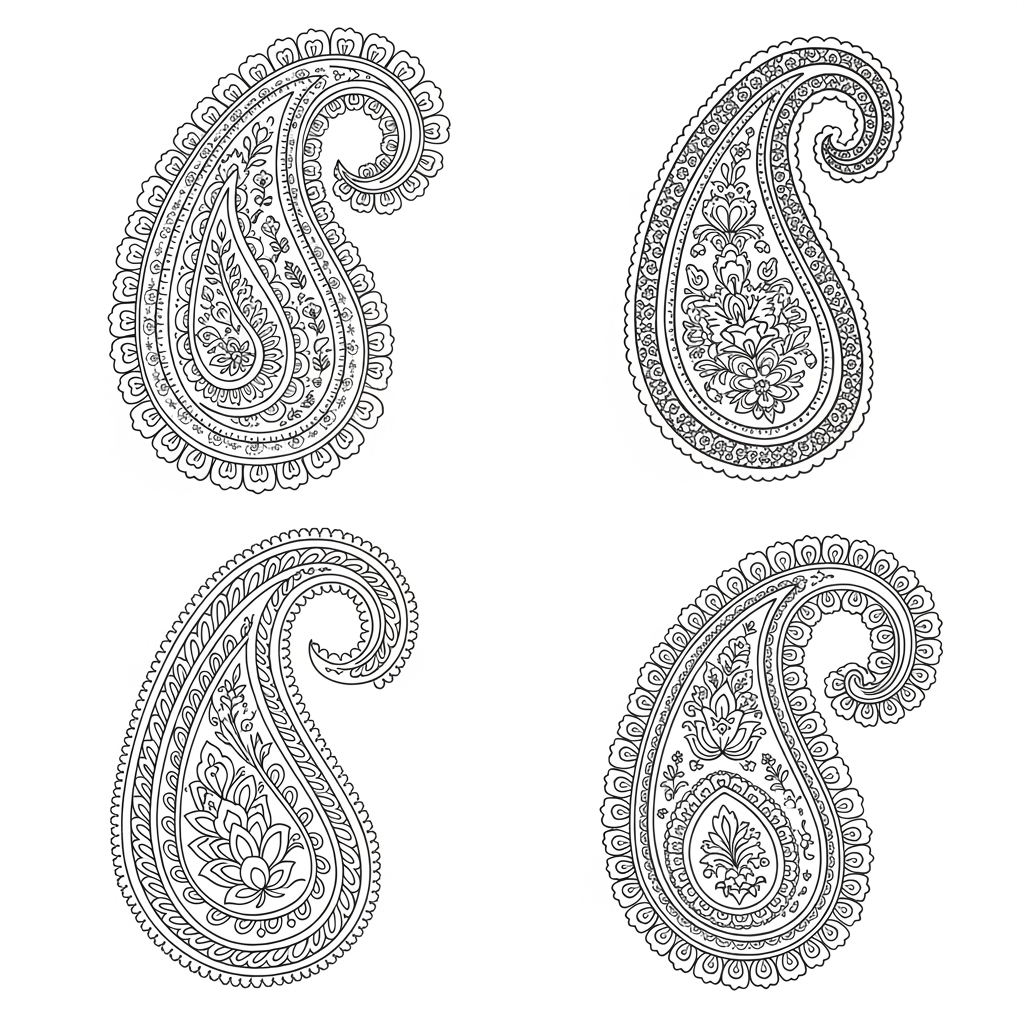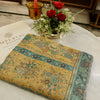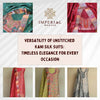Kani Weave Motifs Explained
- by PUJA BHATIA

A Complete Guide to Their Meaning and Heritage
Kani weaving is one of the most intricate and celebrated textile arts of India, originating from the picturesque valleys of Kashmir. While the technique and craftsmanship make Kani sarees and shawls world-famous, what truly sets them apart are the motifs—the timeless patterns that tell stories of culture, history, and artistry.
Every motif in a Kani weave has a meaning, a purpose, and a deep-rooted connection to Kashmiri traditions. These motifs are not mere decorations; they are symbols of nature, life, and cultural richness. This guide will take you through the history, symbolism, and popular types of motifs used in Kani weaves, helping you appreciate the beauty and depth behind these designs.
1. The Legacy of Kani Weave Motifs
The art of Kani weaving dates back to ancient times and is believed to have flourished during the Mughal era, where it found royal patronage. These motifs were originally inspired by the natural beauty of Kashmir—its lush gardens, blooming flowers, flowing rivers, and majestic chinar trees. Over time, these motifs became an integral part of Kani textiles, symbolizing prosperity, spirituality, and the connection between man and nature.
The weaving of these motifs is done using a coded design language called Talim, which guides the artisan on where to place each colored yarn. This allows them to create complex patterns using tiny wooden sticks called Kanis. Each motif is woven thread by thread, making the entire process extremely labor-intensive and highly detailed.
2. Why Are Kani Motifs Important?
Motifs in Kani weaves are not random designs—they carry historical significance and cultural meaning. Here’s why they are special:
Symbolism: Many motifs represent life, fertility, growth, and prosperity.
Artistic Identity: Each motif reflects Kashmiri aesthetics and Mughal artistry.
Heirloom Value: Traditional motifs are passed down through generations of artisans.
Global Recognition: These motifs make Kani weaves unique and distinguishable from other handloom crafts.
3. Types of Kani Weave Motifs and Their Meanings
Kani motifs are diverse, ranging from natural elements to symbolic patterns. Below are the most iconic motifs explained:
A) Paisley (Ambi or Buta)
The paisley motif is one of the most recognizable patterns in Kani weaves. Originating from Persian influence, it resembles a teardrop or mango shape and symbolizes fertility, abundance, and eternal life.
Meaning: Fertility, prosperity, continuity of life.
Usage: Found in borders, pallu, and all-over patterns on sarees and shawls.
B) Chinar Leaf (Maple Leaf)
The chinar tree is an iconic symbol of Kashmir, and its leaf is a recurring motif in Kani weaving. It represents strength, beauty, and the cultural soul of Kashmir.
Meaning: Endurance, strength, connection to nature.
Usage: Commonly woven in vibrant shades of red, orange, and green to mimic the autumn beauty of Kashmir.
C) Gulab (Rose) and Floral Vines
Floral motifs dominate Kani designs, reflecting the Mughal garden aesthetics. Roses, lotuses, and intricate vines are woven to create a feeling of natural beauty and harmony.
Meaning: Love, purity, elegance.
Usage: Spread across the saree body and pallu, often combined with vines (Bel).
D) Jaal (Mesh or Trellis)
The Jaal motif features an interconnected mesh of vines and flowers, creating a rich, continuous design. It is considered one of the most luxurious and intricate patterns in Kani weaving.
Meaning: Eternity, interconnectedness of life.
Usage: Full-body designs on premium Kani sarees and Jamawar shawls.
E) Shikargah (Hunting Scenes)
A rare and highly prized motif, Shikargah depicts royal hunting scenes with animals, birds, and forest elements. These designs were traditionally woven for royalty.
Meaning: Power, grandeur, royal heritage.
Usage: Limited-edition heritage pieces and luxury wraps.
F) Badam (Almond)
The almond motif is another iconic design in Kashmiri weaves, symbolizing health, wealth, and good fortune.
Meaning: Prosperity, wellness, auspiciousness.
Usage: Often combined with floral elements for festive designs.
G) Zaaldar Motifs
These motifs involve intricate patterns covering the entire fabric with detailed miniature designs. They are considered the most complex and time-consuming.
Meaning: Luxury, richness, grandeur.
Usage: High-end Kani sarees and Jamawar shawls for weddings and heirloom collections.
4. The Process Behind Creating Kani Motifs
Creating motifs in Kani weaving is a skill that requires years of training and precision. Here’s how it works:
- Design Creation: Artisans draw the motifs on a graph and convert them into a Talim code.
- Talim Reading: The code instructs where each colored yarn should be placed.
- Hand Weaving: Using wooden Kanis, the artisan manually inserts threads according to the design.
- Finishing: After months of weaving, the fabric undergoes washing and finishing for final use.
Each motif is carefully executed thread by thread, which is why Kani weaves are considered among the most intricate and luxurious textiles in the world.
5. How Motifs Influence Kani Saree Designs
The motifs play a key role in defining the look and personality of a Kani saree:
- Traditional Look: Classic motifs like paisley, chinar, and floral vines.
- Royal & Heritage Appeal: Shikargah and Jaal motifs for opulent occasions.
- Modern Aesthetics: Minimalist floral patterns and geometric motifs for contemporary styling.
Whether you choose a saree with bold chinar motifs or an all-over Jaal pattern, the design reflects your style and the timeless legacy of Kashmiri craftsmanship.
6. Styling Kani Sarees with Motifs
When styling Kani sarees, the motif size and placement matter:
- Small Motifs (Buti Style): Pair with heavy jewelry for a regal look.
- Bold Motifs on Pallu: Keep accessories minimal to highlight the design.
- All-over Jaal Designs: Go for simple accessories for a balanced look.
- Shikargah Motifs: Perfect for elaborate and heritage-themed events with traditional gold ornaments.
7. Why Choose Imperial Weaves for Authentic Motifs?
At Imperial Weaves, we specialize in authentic Kani sarees featuring traditional and modern motifs. Here’s what sets us apart:
-
Original Designs: Each motif is created by skilled Kashmiri artisans.
Exclusive Collections: From paisley-rich Jamawars to Shikargah masterpieces. - Video shopping available: this enable you to understand the motifs and examine the weaved patterns closely.
- Worldwide Delivery: Authentic Kani sarees shipped globally.
When you buy from Imperial Weaves, you own a piece of history.
8. FAQs About Kani Weave Motifs
Q1: Which is the most popular Kani motif?
Paisley and Chinar leaf motifs are the most iconic and widely used in Kani sarees.
Q2: Do motifs change over time?
Yes, while traditional motifs like paisleys remain popular, modern Kani sarees incorporate minimal and contemporary motifs for younger audiences.
Q3: Are motifs handwoven or printed?
In authentic Kani sarees, motifs are handwoven, not printed or embroidered.
Q4: Which motifs are considered royal?
Shikargah, Jamawar and Jaal motifs are historically associated with royalty due to their complexity and grandeur.
9. Final Thoughts – The Story Behind Every Motif
Kani motifs are more than patterns—they are stories woven into silk, carrying centuries of tradition, artistry, and meaning. Every paisley, chinar leaf, and floral vine in your saree is a symbol of Kashmiri heritage. Owning a Kani saree means owning a narrative of nature, culture, and craftsmanship.
At Imperial Weaves, we bring you authentic Kani sarees with traditional and modern motifs, ensuring unmatched quality and heritage preservation. Explore our collection and discover the beauty behind every motif.
Shop Now: www.imperialweaves.com






